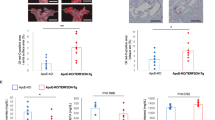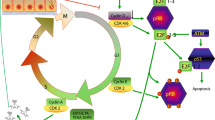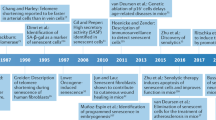Abstract
Recent evidence suggests that high dose and/or long term use of proton pump inhibitors (PPIs) may increase the risk of adverse cardiovascular events in older patients, but mechanisms underlying these detrimental effects are not known. Taking into account that the senescent endothelial cells have been implicated in the genesis or promotion of age-related cardiovascular disease, we hypothesized an active role of PPIs in senescent cells. The aim of this study is to investigate the changes in gene expression occurring in senescent and non-senescent human coronary artery endothelial cells (HCAECs) following Omeprazole (OPZ) or Lansoprazole (LPZ) treatment. Here, we show that atherogenic response is among the most regulated processes in PPI-treated HCAECs. PPIs induced down-regulation of anti-atherogenic chemokines (CXCL11, CXCL12 and CX3CL1) in senescent but not in non-senescent cells, while the same chemokines were up-regulated in untreated senescent cells. These findings support the hypothesis that up-regulated anti-atherogenic chemokines may represent a defensive mechanism against atherosclerosis during cellular senescence, and suggest that PPIs could activate pro-atherogenic pathways by changing the secretory phenotype of senescent HCAECs. Moreover, the genes coding for fatty acid binding protein 4 (FABP4) and piezo-type mechanosensitive ion channel component 2 (PIEZO2) were modulated by PPIs treatment with respect to untreated cells. In conclusions, our results show that long-term and high dose use of PPI could change the secretory phenotype of senescent cells, suggesting one of the potential mechanisms by which use of PPI can increase adverse outcomes in older subjects.




Similar content being viewed by others
References
Akhtar S, Gremse F, Kiessling F, Weber C, Schober A (2013) CXCL12 promotes the stabilization of atherosclerotic lesions mediated by smooth muscle progenitor cells in Apoe-deficient mice. Arterioscler Thromb Vasc Biol 33:679–686
Bagriantsev SN, Gracheva EO, Gallagher PG (2014) Piezo proteins: regulators of mechanosensation and other cellular processes. J Biol Chem 289:31673–31681
Bell JS, Strandberg TE, Teramura-Gronblad M, Laurila JV, Tilvis RS, Pitkälä KH (2010) Use of proton pump inhibitors and mortality among institutionalized older people. Arch Intern Med 170:1604–1605
Brandes RP, Fleming I, Busse R (2005) Endothelial aging. Cardiovasc Res 66:286–294
Broch K, Ueland T, Yndestad A, Aukrust P, Gullestad L (2012) Heart failure biomarkers: focus on interleukin-1 receptor-like 1-based blood tests. Drugs Today (Barc) 48:479–491
Campisi J (2013) Aging, cellular senescence, and cancer. Annu Rev Physiol 75:685–705
Charlot M, Ahlehoff O, Norgaard ML, Jørgensen CH, Sørensen R, Abildstrøm SZ, Hansen PR, Madsen JK, Køber L, Torp-Pedersen C, Gislason G (2010) Proton-pump inhibitors are associated with increased cardiovascular risk independent of clopidogrel use: a nationwide cohort study. Ann Intern Med 153:378–386
Childs BG, Durik M, Baker DJ, van Deursen JM (2015) Cellular senescence in aging and age-related disease: from mechanisms to therapy. Nat Med 21:1424–1435
Chung HY, Cesari M, Anton S, Marzetti E, Giovannini S, Seo AY, Carter C, Yu BP, Leeuwenburgh C (2009) Molecular inflammation: underpinnings of aging and age-related diseases. Ageing Res Rev 8:18–30
Corsonello A, Maggio M, Fusco S, Adamo B, Amantea D, Pedone C, Garasto S, Ceda GP, Corica F, Lattanzio F, Antonelli Incalzi R (2014) Proton pump inhibitors and functional decline in older adults discharged from acute care hospitals. J Am Geriatr Soc 62:1110–1115
de Jager CP, Wever PC, Gemen EF, van Oijen MG, van Gageldonk-Lafeber AB, Siersema PD, Kusters GC, Laheij RJ (2012) Proton pump inhibitor therapy predisposes to community-acquired Streptococcus pneumoniae pneumonia. Aliment Pharmacol Ther 36:941–949
Debacq-Chainiaux F, Erusalimsky JD, Campisi J, Toussaint O (2009) Protocols to detect senescence-associated beta-galactosidase (SA-betagal) activity, a biomarker of senescent cells in culture and in vivo. Nat Protoc 4:1798–1806
Der G (2003) An overview of proton pump inhibitors. Gastroenterol Nurs 26:182–190
Elmasri H, Karaaslan C, Teper Y, Ghelfi E, Weng M, Ince TA, Kozakewich H, Bischoff J, Cataltepe S (2009) Fatty acid binding protein 4 is a target of VEGF and a regulator of cell proliferation in endothelial cells. FASEB J 23:3865–3873
Elmasri H, Ghelfi E, Yu CW, Traphagen S, Cernadas M, Cao H, Shi GP, Plutzky J, Sahin M, Hotamisligil G, Cataltepe S (2012) Endothelial cell-fatty acid binding protein 4 promotes angiogenesis: role of stem cell factor/c-kit pathway. Angiogenesis 15:457–468
Erusalimsky JD (2009) Vascular endothelial senescence: from mechanisms to pathophysiology. J Appl Physiol 106:326–332
Erusalimsky JD, Kurz DJ (2005) Cellular senescence in vivo: its relevance in ageing and cardiovascular disease. Exp Gerontol 40:634–642
Ghebremariam YT, LePendu P, Lee JC, Erlanson DA, Slaviero A, Shah NH, Leiper J, Cooke JP (2013) Unexpected effect of proton pump inhibitors: elevation of the cardiovascular risk factor asymmetric dimethylarginine. Circulation 128:845–853
Ghebremariam YT, Cooke JP, Khan F, Thakker RN, Chang P, Shah NH, Nead KT, Leeper NJ (2015) Proton pump inhibitors and vascular function: a prospective cross-over pilot study. Vasc Med 20:309–316
Gizard F, Amant C, Barbier O, Bellosta S, Robillard R, Percevault F, Sevestre H, Krimpenfort P, Corsini A, Rochette J, Glineur C, Fruchart JC, Torpier G, Staels B (2005) PPAR alpha inhibits vascular smooth muscle cell proliferation underlying intimal hyperplasia by inducing the tumor suppressor p16INK4a. J Clin Investig 115:3228–3238
Hadi HA, Carr CS, Al Suwaidi J (2005) Endothelial dysfunction: cardiovascular risk factors, therapy, and outcome. Vasc Health Risk Manag 1:183–198
Haendeler J, Hoffmann J, Diehl JF, Vasa M, Spyridopoulos I, Zeiher AM, Dimmeler S (2004) Antioxidants inhibit nuclear export of telomerase reverse transcriptase and delay replicative senescence of endothelial cells. Circ Res 94:768–775
Ho JE, Larson MG, Ghorbani A, Cheng S, Vasan RS, Wang TJ, Januzzi JL Jr (2013) Soluble ST2 predicts elevated SBP in the community. J Hypertens 31:1431–1436
Hu YR, Qiao HL, Kan QC (2004) Pharmacokinetics of lansoprazole in Chinese healthy subjects in relation to CYP2C19 genotypes. Acta Pharmacol Sin 25:986–990
Khanna AK (2009) Enhanced susceptibility of cyclin kinase inhibitor p21 knockout mice to high fat diet induced atherosclerosis. J Biomed Sci 16:66
Krizhanovsky V, Yon M, Dickins RA, Hearn S, Simon J, Miething C, Yee H, Zender L, Lowe SW (2008) Senescence of activated stellate cells limits liver fibrosis. Cell 134:657–667
Lawson C, Wolf S (2009) ICAM-1 signaling in endothelial cells. Pharmacol Rep 6:22–32
Lazarus B, Chen Y, Wilson FP, Sang Y, Chang AR, Coresh J, Grams ME (2016) Proton pump inhibitor use and the risk of chronic kidney disease. JAMA Intern Med 176:238–246
Lerman A, Burnett JC Jr (1992) Intact and altered endothelium in regulation of vasomotion. Circulation 86:III12–19
Linsky A, Gupta K, Lawler EV, Fonda JR, Hermos JA (2010) Proton pump inhibitors and risk for recurrent Clostridium difficile infection. Arch Intern Med 170:772–778
Liu KH, Kim MJ, Shon JH, Moon YS, Seol SY, Kang W, Cha IJ, Shin JG (2005) Stereoselective inhibition of cytochrome P450 forms by lansoprazole and omeprazole in vitro. Xenobiotica 35:27–38
Liu Y, Sanoff HK, Cho H, Burd CE, Torrice C, Mohlke KL, Ibrahim JG, Thomas NE, Sharpless NE (2009) INK4/ARF transcript expression is associated with chromosome 9p21 variants linked to atherosclerosis. PLoS ONE 4:e5027
Maciag T, Hoover GA, Stemerman MB, Weinstein R (1981) Serial propagation of human endothelial cells in vitro. J Cell Biol 91:420–426
Maggio M, Corsonello A, Ceda GP, Cattabiani C, Lauretani F, Buttò V, Ferrucci L, Bandinelli S, Abbatecola AM, Spazzafumo L, Lattanzio F (2013) Proton pump inhibitors and risk of 1-year mortality and rehospitalization in older patients discharged from acute care hospitals. JAMA Intern Med 173:518–523
Matz RL, Andriantsitohaina R (2003) Age-related endothelial dysfunction: potential implications for pharmacotherapy. Drugs Aging 20:527–550
McCarthy DM (2010) Adverse effects of proton pump inhibitor drugs: clues and conclusions. Curr Opin Gastroenterol 26:624–631
McEver RP (2015) Selectins: initiators of leucocyte adhesion and signalling at the vascular wall. Cardiovasc Res 107:331–339
Mercer J, Figg N, Stoneman V, Braganza D, Bennett MR (2005) Endogenous p53 protects vascular smooth muscle cells from apoptosis and reduces atherosclerosis in ApoE knockout mice. Circ Res 96:667–674
Rajab A, Touma M, Rudler H, Afonso C, Seuleiman M (2013) Slow, spontaneous degradation of lansoprazole, omeprazole and pantoprazole tablets: isolation and structural characterization of the toxic antioxidants 3H-benzimidazole-2-thiones. Pharmazie 68:749–754
Ranade SS, Qiu Z, Woo SH, Hur SS, Murthy SE, Cahalan SM, Xu J, Mathur J, Bandell M, Coste B, Li YS, Chien S, Patapoutian A (2014) Piezo1, a mechanically activated ion channel, is required for vascular development in mice. Proc Natl Acad Sci U S A. 111:10347–10352
Rodier F, Campisi J (2011) Four faces of cellular senescence. J Cell Biol 192:547–556
Rousselle A, Qadri F, Leukel L, Yilmaz R, Fontaine JF, Sihn G, Bader M, Ahluwalia A, Duchene J (2013) CXCL5 limits macrophage foam cell formation in atherosclerosis. J Clin Investig 123:1343–1347
Schirmer SH, Degen A, Baumhäkel M, Custodis F, Schuh L, Kohlhaas M, Friedrich E, Bahlmann F, Kappl R, Maack C, Böhm M, Laufs U (2012) Heart-rate reduction by If-channel inhibition with ivabradine restores collateral artery growth in hypercholesterolemic atherosclerosis. Eur Heart J 33:1223–1231
Shah NH, LePendu P, Bauer-Mehren A, Ghebremariam YT, Iyer SV, Marcus J, Nead KT, Cooke JP, Leeper NJ (2015) Proton pump inhibitor usage and the risk of myocardial infarction in the general population. PLoS ONE 10:e0124653
Sheikine Y, Deodato B, Olofsson PS, Söderström LA, Lundberg AM, Bodin I, Rudling M, Theodorsson E, Hansson GK (2010) Activation of VPAC1 receptors aggravates early atherosclerosis in hypercholesterolemic apolipoprotein E-deficient mice. Biochem Biophys Res Commun 402:471–476
Tchkonia T, Zhu Y, van Deursen J, Campisi J, Kirkland JL (2013) Cellular senescence and the senescent secretory phenotype: therapeutic opportunities. J Clin Investig 123:966–972
Thumser AE, Moore JB, Plant NJ (2014) Fatty acid binding proteins: tissue-specific functions in health and disease. Curr Opin Clin Nutr Metab Care 17:124–129
Wang XP, Cheng ZY2, Schmid KL3 (2014) GABAB receptors expressed in human aortic endothelial cells mediate intracellular calcium concentration regulation and endothelial nitric oxide synthase translocation. Biomed Res Int 871735.
Xue W, Zender L, Miething C, Dickins RA, Hernando E, Krizhanovsky V, Cordon-Cardo C, Lowe SW (2007) Senescence and tumour clearance is triggered by p53 restoration in murine liver carcinomas. Nature 445:656–660
Yepuri G, Sukhovershin R, Nazari-Shafti TZ, Petrascheck M, Ghebre YT, Ghebre YT, Cooke JP (2016) Proton pump inhibitors accelerate endothelial senescence. Circ Res. doi:10.1161/CIRCRESAHA.116.308807
Zimmerman AW, Veerkamp JH (2002) New insights into the structure and function of fatty acid-binding proteins. Cell Mol Life Sci 59:1096–1116
Acknowledgements
This study was supported by Grant RF-2010-2312659 from the Italian Ministry of Health and Emilia Romagna Region.
Author information
Authors and Affiliations
Corresponding author
Electronic supplementary material
Below is the link to the electronic supplementary material.
Rights and permissions
About this article
Cite this article
Costarelli, L., Giacconi, R., Malavolta, M. et al. Different transcriptional profiling between senescent and non-senescent human coronary artery endothelial cells (HCAECs) by Omeprazole and Lansoprazole treatment. Biogerontology 18, 217–236 (2017). https://doi.org/10.1007/s10522-016-9675-3
Received:
Accepted:
Published:
Issue Date:
DOI: https://doi.org/10.1007/s10522-016-9675-3




